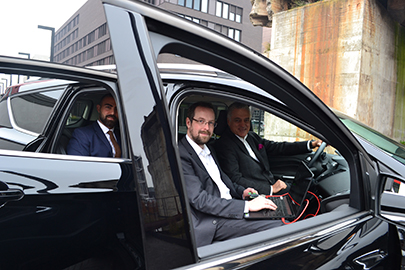Hackers are infamous for going after bank accounts, emails of presidential candidates or the control centres of power plants. IT experts are familiar with these attacks and have a high success rate in thwarting them. But there is a whole new set of vulnerabilities open to attack in complex control systems – like those used in cars.
This is true as much for the cars we’re driving today as for the autonomous vehicles that could be driving us tomorrow. Accordingly, SnT researchers are already hard at work developing defence systems to tackle this challenge.

Dr. David Kozhaya, Dr. Marcus Völp and Prof. Paulo Esteves-Veríssimo
“One key to security is diversity of components,” explains Dr. Marcus Völp, a researcher at SnT. If a hacker manages to crack the brake system of one manufacturer, for example, that doesn’t necessarily mean he can get into the brake system of another.
Unfortunately, not all components are so diverse. Project lead Prof. Dr. Paulo Esteves-Veríssimo confirms this. “The Controller Area Network (CAN) bus used to connect electronics in most cars nowadays isn’t safe. In experiments, experts were able to take control of an SUV using radio waves alone, and make it involuntarily drive in reverse.”
The risk of these attacks is even greater in autonomous vehicles that need to communicate with one another. Scientists at SnT are therefore cooperating with the Intel Collaborative Research Institute for Collaborative Autonomous & Resilient Systems (ICRICARS) to tackle new challenges in the IT security of autonomous driving. “The future of vehicles isn’t so much fully autonomous cars but cooperative vehicles,” explains Dr. David Kozhaya. He continues: “the cars of tomorrow will wirelessly communicate to their environment where they are and where they want to go.”
This networking between vehicles, however, opens up new channels that malicious attackers can exploit. What would happen, for example, if a hacker were to force a vehicle to report a false location or the wrong speed limit?
Völp outlines the challenge: “The vehicle’s systems must be able to identify when there is something wrong with the data. Then, they must immediately decide which data can be trusted and which cannot.”
One part of the solution is to include multiple components serving the same purpose but based on different systems. If one of these is compromised, the vehicle can still reconcile in real time which data is correct and which should be discarded. SnT and Intel are working together to ensure this all happens in a quick and reliable manner so that vehicles will be able to share the optimised traffic information securely among themselves.
